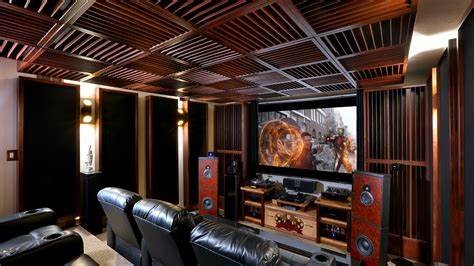Home Theatre Acoustics
 Home theatre acoustic treatment is a vital project that every soundproofing engineer should undertake. Even with the quietest projector, there is, without properly acoustically treated home theatre, you won’t enjoy your movies. Home theatre acoustics provides the direct to reflected sound ratio in accordance with the critical distance from the hearing position. Below points has to be considered in designing a Home Theatre.
As we’ve heard from thousands of customers over the years, a well-designed home theatre room will quickly become your favorite room in the house.
While it’s nice to have a beautiful picture and loud booming sound effects, when it all comes down to it, the most important part of a movie is the dialogue. If you can not understand the dialogue, you can not follow along with the plot..
We are committed to provide excellent craftsmanship, exceptional product selection and customer contentment all at competitive prices. We provide you acoustic ceiling , soundproof wall panels that give you sound proofing services that absorb echo, reduce noise, reverberation sounds within the space and restore a room to premium sound quality.
Home theatre acoustic treatment is a vital project that every soundproofing engineer should undertake. Even with the quietest projector, there is, without properly acoustically treated home theatre, you won’t enjoy your movies. Home theatre acoustics provides the direct to reflected sound ratio in accordance with the critical distance from the hearing position. Below points has to be considered in designing a Home Theatre.
As we’ve heard from thousands of customers over the years, a well-designed home theatre room will quickly become your favorite room in the house.
While it’s nice to have a beautiful picture and loud booming sound effects, when it all comes down to it, the most important part of a movie is the dialogue. If you can not understand the dialogue, you can not follow along with the plot..
We are committed to provide excellent craftsmanship, exceptional product selection and customer contentment all at competitive prices. We provide you acoustic ceiling , soundproof wall panels that give you sound proofing services that absorb echo, reduce noise, reverberation sounds within the space and restore a room to premium sound quality. - Soundproof Doors
- Home Theatre Flooring
Carpeted Floors with underlay help Control Home Theatre Sound limiting the bounce of Audio.
- Ceiling Panels
One of the best practices for designing Home Theatre Acoustics is to isolate the Joists and we have different solutions starting from Acoustic Ceiling panels or suspending Acoustic Clouds from the ceiling.
- HVAC Vents Sound Proofing
Sound Proofing Of Noise Vents is a key parameter to be considered in designing any Home Theatre Rooms. Missing that element can result in the whole design useless. Sound travels easily through the AC ventilators and usage of duct liners and sound baffles can dampen the sound which is passing through the ducts.
- Wall Acoustic Panels
A home theatre room with practically no acoustic treatment will have sound waves reflecting from all surfaces of the room. To keep the sound reflections to a minimum, sound absorption panel with insulation is required.
Frequently Asked Questions
You can improve acoustics by using acoustic panels, bass traps, and diffusers, as well as optimizing speaker placement and room layout. Working with a professional acoustic consultant is recommended.
Acoustic consultants in Dubai can assess your specific space, recommend tailored solutions, and ensure that your home theater meets local regulations and standards for noise control.
Common solutions include acoustic panels, soundproof curtains, acoustic foam, and wall treatments to control sound reflections and enhance the listening experience.
Acoustic solutions come in various designs and colors, allowing you to select options that complement your home theater’s aesthetics while improving sound quality.
The cost can vary widely based on the size of your room, the materials used, and the level of acoustic treatment required. It’s advisable to get quotes from acoustic specialists.
Room size affects the acoustics of your home theater. Smaller rooms may require more sound absorption, while larger rooms may need additional speakers and diffusion to achieve the desired audio quality.
Soundproofing measures include adding mass to walls and ceilings, sealing gaps and cracks, and using soundproof curtains or doors. Consult with a professional for the best results.
Proper room layout can minimize acoustic issues. Avoid placing seating too close to walls and corners, as this can cause sound reflections and distortions.
A subwoofer enhances low-frequency effects in movies and music. Place it in a corner or along a wall for optimal bass response, but experiment with placement to find the best spot for your room.
